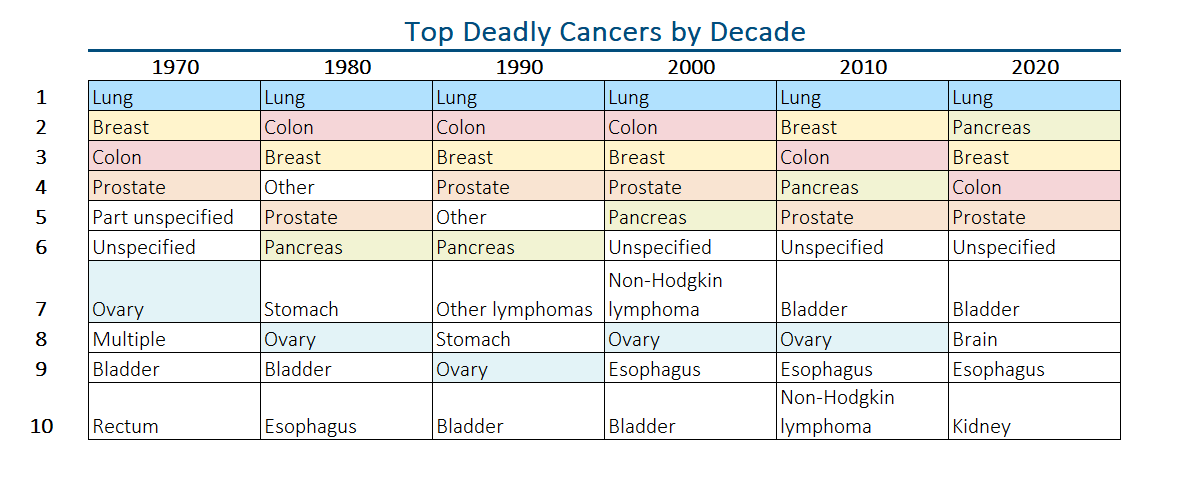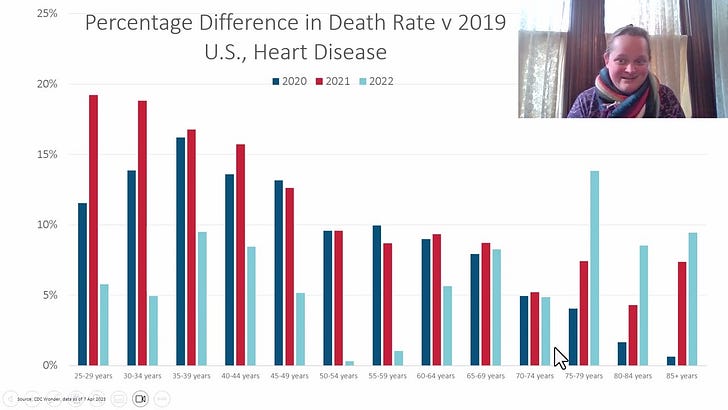Top Cancer Types: By Crude Death Rate, 1968-2023
Looking at some simple ranking
I didn’t intend this to be Cancer Week, but it is. After my last post, the following two pieces of news were released:
Reuters: King Charles diagnosed with cancer, will postpone duties and undergo treatment
King Charles has been diagnosed with a form of cancer and will postpone public engagements to undergo treatment, Buckingham Palace said on Monday, but added he remained "wholly positive" about the scare less than 18 months into his reign.
Charles, 75, who became king in September 2022 following the death of his mother Queen Elizabeth, has begun a series of treatments, the palace said, adding he was looking forward to returning to fulltime duties as soon as possible.
….
"No further details are being shared at this stage, except to confirm that his majesty does not have prostate cancer," the palace said.
Toby Keith had been diagnosed with stomach cancer in 2022.
Top Cancer Types by Death Rate, Selected Years
One of the issues in using the historical record of CDC WONDER is that the ICD codes changed from 1968 to now, and the definitions don’t quite match up. However, there are pretty close matches in the top cancer death types in the ranking tables.
I did get the data from 1968 to 2023 (provisional), but to keep it looking pretty, let’s just look at the decadal years:
You’ll note I colored some of the cancer types so you can see how the ranking has changed among the decades:
Lung cancer is the #1 killer throughout
Pancreatic cancer has grown as a killer, in ranking
Breast has been #2/#3 throughout
Prostate has gone up & down
I could have marked out bladder (I did not), stomach, the lymphomas, etc. But we will ignore those. I did mark ovary, because I was wondering if something was going on….
….but it was difficult to tell.
Then there was all those odd “Other” and “part unspecified” and “Unspecified”… and to note, I had greatly simplified the description of the ICD code information in the table above. So time for a jump down the rabbit hole.
Simplifying the jargon, but it’s important
A quick comment about the “part unspecified” and “unspecified”, etc — I greatly simplified the description from the codes.
There were three sets of codes through this period: ICD-8 through ICD-10, and there is a lot of overlap in the coding descriptions and instructions.
I deleted a lot of the jargony words like “neoplasms” in place of our more familiar “cancer”.
But this “unspecified” has to do with the location of the cancer.
Sometimes, when people die of cancer, it’s so late, that they have no idea where the cancer originated. It thoroughly metastasized — and spread throughout the body.
The “Unspecified” category ranked #6 for 2000, 2010, and 2020 is ICD-10 code:
C80 Malignant neoplasm without specification of site
To get personal for a moment, while Stu’s cancer had metastasized when it had been found, spread into his bones throughout his body, it could be tested and discovered it had originated from the prostate. He had been lucky that it had been caught early enough to be treated and beaten back. (Note: not curable, but treatable)
Many are not so lucky.
But there is something else to thing about — that’s the ranking change over the decades. What is actually going on wi
Difference between ranking and rate
The reason I had colored specific types of cancer, I wanted to graph the them over time so you can see how their death rates have changed 1968-2023.
I think you can see why lung cancer is rated number one for deaths.
But note the movements: some increased, then decreased:
lung
colon
breast
Ovarian cancer looks mainly level in its death rates.
Prostate cancer I’ve written about extensively in my Movember fundraising, but there has been a concerning trend in recent years. Similar to breast cancer, there had been a decrease after improved screening and treatment, but we’ve seen increases again.
But the one we’ve seen with a bad trend, just a plain bad trend: pancreatic cancer.
And that’s one with a bad prognosis if you’ve been diagnosed.
Related Posts
February 2020: Mortality with Meep: Cancer Statistics -- an Introduction
Movember 2023: Prostate Cancer Mortality Trend Update
Let’s take a look at recent prostate cancer mortality experience, which has a disturbing recent trend, but first, let’s check in on the fundraiser. Movember Fundraiser First, here are the places you can donate to the Movember Foundation, which supports men’s health, specifically focusing on prostate cancer, testicular cancer, and men’s mental health:
Movember 2023 - Current Status and Trends
Looking at my Movember 2023 fundraiser, its current progress, and concerns over how cancer screening and treatment may have been interrupted during the pandemic.










What about cervical cancer? is that included in the ovarian group? Or is it now insignificant in the US due to early detection? My mother lost her battle with cancer 22 years ago at the tender age of 56.